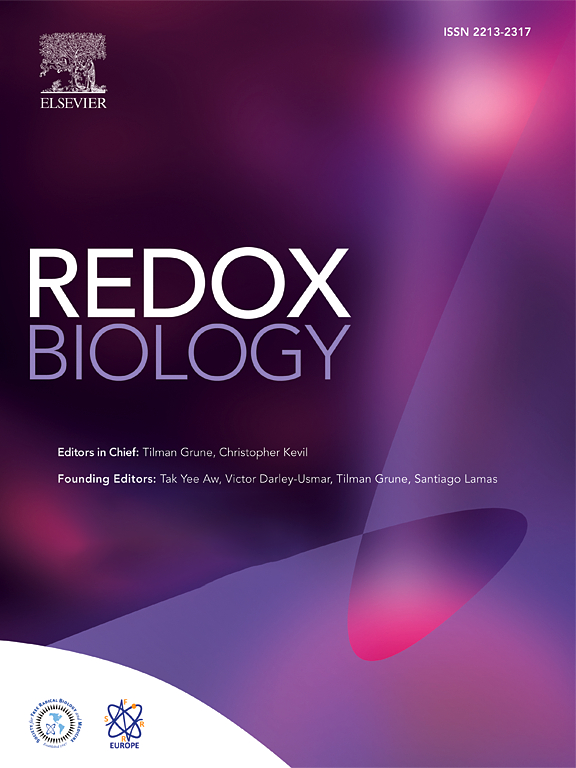ipsc衍生的心肌细胞和工程化心脏组织显示,在lmna相关的心肌萎缩症中,JAK2/STAT3信号被抑制
IF 10.7
1区 生物学
Q1 BIOCHEMISTRY & MOLECULAR BIOLOGY
引用次数: 0
摘要
与 LMNA 基因突变相关的艾默里-德赖福斯肌营养不良症(LMNA 相关 EDMD)是一种罕见的遗传性疾病,常伴有危及生命的心脏并发症。然而,LMNA突变与其相关的EDMD心脏表型之间的分子联系仍不清楚。在这里,我们利用EDMD患者特异性基因组编辑的诱导多能干细胞衍生心肌细胞(iPSC-CMs),将LMNA L204P突变与心律失常和收缩功能障碍的致病表型联系起来。通过多组学分析,我们发现 LMNA L204P 会导致染色质可及性降低,从而导致 EDMD iPSC-CMs 中的 JAK2 下调。从机理上讲,EDMD iPSC-CMs 中的 JAK2/STAT3 信号通路抑制会引起线粒体功能障碍和氧化应激,最终导致上述表型。相反,通过药物或基因激活 JAK2/STAT3 信号通路,可改善线粒体功能,从而有效挽救 EDMD iPSC-CMs 的心律失常和收缩功能障碍表型。此外,虽然 EDMD 工程心脏组织(EHTs)显示出收缩力生成功能障碍,但 STAT3 激活也能显著缓解这种情况。综上所述,我们发现染色质区室变化介导的 JAK2/STAT3 抑制是 LMNA 相关 EDMD 心脏致病表型的一种新机制。我们的研究结果表明,激活 JAK2/STAT3 信号通路有可能成为治疗这种疾病的一种新策略。本文章由计算机程序翻译,如有差异,请以英文原文为准。

iPSC-derived cardiomyocytes and engineered heart tissues reveal suppressed JAK2/STAT3 signaling in LMNA-related emery-dreifuss muscular dystrophy
LMNA mutation related Emery-Dreifuss muscular dystrophy (LMNA-related EDMD), is a rare genetic disorder often involving life‐threatening cardiac complications. However, the molecular links between LMNA mutations and their related EDMD cardiac phenotypes have remained unclear. Here, using EDMD patient-specific and genome-edited induced pluripotent stem cell-derived cardiomyocytes (iPSC-CMs), we link the LMNA L204P mutation with the pathogenic phenotypes of arrhythmia and contractile dysfunction. Using multi-omics analysis, we then show that LMNA L204P results in decreased chromatin accessibility, leading to the downregulation of JAK2 in EDMD iPSC-CMs. Mechanistically, JAK2/STAT3 signaling pathway suppression in EDMD iPSC-CMs is shown to cause mitochondrial dysfunction and oxidative stress, ultimately resulting in the above phenotypes. Conversely, pharmacological or genetic activation of JAK2/STAT3 signaling effectively rescues both the arrhythmic and contractile dysfunction phenotypes in EDMD iPSC-CMs via improvements in mitochondrial function. In addition, whilst EDMD engineered heart tissues (EHTs) display dysfunctional contractile force generation, this can also be significantly alleviated by STAT3 activation. Taken together, we present chromatin compartment change-mediated JAK2/STAT3 suppression as a novel mechanism underlying cardiac pathogenic phenotypes in LMNA-related EDMD. Our findings indicate that activating the JAK2/STAT3 signaling pathway may hold the potential to serve as a novel therapeutic strategy for this condition.
求助全文
通过发布文献求助,成功后即可免费获取论文全文。
去求助
来源期刊

Redox Biology
BIOCHEMISTRY & MOLECULAR BIOLOGY-
CiteScore
19.90
自引率
3.50%
发文量
318
审稿时长
25 days
期刊介绍:
Redox Biology is the official journal of the Society for Redox Biology and Medicine and the Society for Free Radical Research-Europe. It is also affiliated with the International Society for Free Radical Research (SFRRI). This journal serves as a platform for publishing pioneering research, innovative methods, and comprehensive review articles in the field of redox biology, encompassing both health and disease.
Redox Biology welcomes various forms of contributions, including research articles (short or full communications), methods, mini-reviews, and commentaries. Through its diverse range of published content, Redox Biology aims to foster advancements and insights in the understanding of redox biology and its implications.
 求助内容:
求助内容: 应助结果提醒方式:
应助结果提醒方式:


